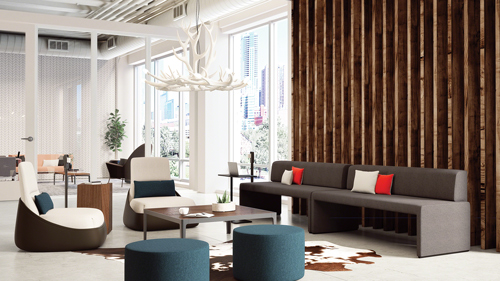Today’s leaders must navigate an economic environment that is far more complex and unpredictable than in the past. Traditional hierarchy-based management practices that previously propelled success can no longer keep pace with the constantly shifting business landscape.
As leaders seek ways to address this new reality, they can take a cue from complex adaptive systems in nature, such as coral reefs, prairies and rainforests. Made up of highlyinterconnected-and-interdependent parts, these systems can quickly adjust and adapt to survive.
The physical workplace is an important agent within an organization that can enable openness, transparency and flexibility, helping leaders create the conditions for an engaged, agile and resilient workforce.
Aspiring business leaders may find that taking a course in biology will serve their companies better than focusing on the standard business curriculum. That’s because successful organizations today are more like a complex adaptive system found in nature and less like hierarchical organizations with military-like command and control structures that past generations of leaders managed.
Systems in nature are made up of highly interconnected and interdependent parts to adjust and adapt as conditions change in order to survive. They cope with unpredictable phenomena by getting feedback from their environment and then changing to meet the new conditions they face. Progressive leaders in today’s dramatically changed business climate are looking to nature as they seek to deal with complexity in new ways and create more adaptive, resilient and engaged organizations.
The risks and rewards inherent in times of change are well known to senior leaders, who have to seize opportunities for growth while sidestepping pitfalls. But there’s a big difference between being aware of a complex, rapidly evolving business landscape and taking successful action to leverage it—especially when the ground beneath them seems to be constantly shifting.
As leaders seek new ways to help their organizations become more agile, many of them have not yet understood or embraced the new biology of their organizations, or considered leading it in fundamentally different ways. And many have not yet recognized that one of the “agents” in their complex adaptive system is the physical workplace, which can be used to help shape new, agile behaviors—or reinforce the ways things have always been done, slowing adoption and hampering organizational resilience.
For over 20 years Steelcase has researched the changing nature of work, including the disruptive elements impacting leaders, using its own leadership spaces as a laboratory. Designed as prototypes to test theories and push the boundaries of how work happens, these spaces have resulted in radically reimagined ways of working and leading, both as individuals and as a team of leaders. The latest research has identified how physical space can help executives lead their organizations like a complex adaptive system and, in turn, reshape the culture and organizational performance overall.
While everything seems to be changing around leaders, either by choice or circumstance, one thing that is fairly enduring are their offices. The vast majority of leaders work in traditional, private offices according to the Steelcase Global Report; 58 percent work in private offices compared to 23 percent of employees. While that disparity is probably not surprising to most, it begs the question of whether leaders have considered the possibility that their workspace could be a catalyst for the type of change they are trying to implement.
The Steelcase leadership prototype had goals that were both universally applicable and specific to the organization. One example of a common problem is to better coalesce a globally distributed executive team. Notes one remotely located leader, “I often found that when we met on video the way the space was organized made it difficult for me to be noticed when I had something to contribute to the conversation. I had to raise my hand when I wanted to speak, which didn’t make me feel like an equal participant.”
Keane specifically wanted to change the role of the leadership space to support the cultural transformation underway in the organization. “I wanted my team to be in an environment that would support and speed our evolution from being top decision makers to what I describe as being curators of the environment,” notes Keane. “Instead of making all the decisions, as curators it’s our job to listen to the pulse and attend to the context, to see opportunities and empower our employees to do what they are equipped to do best.”
A key decision was to continue the executive team journey from higher level floors, which could become isolating without much employee traffic, and move the team to a main-floor crossroads of the campus. Encouraging employees to work in the space too or, at the very least, make it a regular pathway is intended to help leaders be more attuned to a broader context, learn about developments faster and be accessible for impromptu conversations with employees and visiting customers.






0 Comment